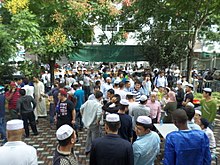मुसलमान
इस्लाम धर्ममा धार्मिक आस्था राख्ने व्यक्तिहरूलाई मुसलमान भनिन्छ। मुसलमानको धार्मिक सिधान्त इस्लाम धर्मको धार्मिक ग्रन्थ कुरआन मा आधारित छ।
 सन् १८६५ कायरोमा नमाजरत मुसलमानहरू | |
| कुल जनसङ्ख्या | |
|---|---|
| १.८ अर्ब विश्वव्यापी (सन् २०१६)[१] | |
| स्थापनाकर्ता | |
| मुहम्मद[२] (मुसलमानहरू आदमलाई संस्थापक मान्दछन्)[३] | |
| उल्लेखनीय जनसङ्ख्या भएका क्षेत्रहरू | |
| २३,६८,००,०००[४] | |
| २०,८८,००,०००[५] | |
| १९,४६,००,०००[६] | |
| १५,१९,००,०००[७] | |
| ९,११,००,०००[८] | |
| ९,५०,००,०००[९] | |
| ८,२९,००,०००[१०] | |
| ८,२८,००,०००[११] | |
| ६,००,००,०००–८,००,००,०००[१२][१३] | |
| ४,२०,००,०००[१४] | |
| धर्म | |
| ८०–९०% सुन्नी इस्लाम १२–१७% सिया इस्लाम[१५] ~१% अह्मदीया ~१% अन्य इस्लामी परम्पराहरू (जस्तै: इवादी इस्लाम)[१६] | |
| शास्त्रहरू | |
| कुरान[१७] | |
| भाषाहरू | |
| अरबी (पवित्र भाषा), उर्दु, बङ्गाली, मलय, फारसी, जाभानी, पञ्जाबी,बेलुच,तुर्केली, हाउसा, चिनियाँ, विघुर ,बोसनियाली, इन्डोनेसियाली, कुर्दी,पश्तो,सेबुवानो,धिवेही र मुस्लिम विश्वभाषा[१८][१९][२०][२१][२२][२३][२४] | |

यी पनि हेर्नुहोस् सम्पादन गर्नुहोस्
सन्दर्भ सामग्रीहरू सम्पादन गर्नुहोस्
- ↑ Lipka, Michael, and Conrad Hackett. 2015] 6 April 2017. "Why Muslims are the world’s fastest-growing religious group" (data analysis). Fact Tank. US: Pew Research Center
- ↑ Alford T. Welch, Ahmad S. Moussalli, Gordon D. Newby (२००९), "Muḥammad", in John L. Esposito, The Oxford Encyclopedia of the Islamic World, Oxford: Oxford University Press, "The Prophet of Islam was a religious, political, and social reformer who gave rise to one of the great civilizations of the world. From a modern, historical perspective, Muḥammad was the founder of Islam. From the perspective of the Islamic faith, he was God's Messenger (rasūl Allāh), called to be a “warner,” first to the Arabs and then to all humankind."
- ↑ Lalljee, compiled by Yousuf N. (१९८१), Know your Islam (3rd संस्करण), New York: Taknike Tarsile Quran, पृ: ७१, आइएसबिएन 978-0-940368-02-6।
- ↑ "The World Factbook — Central Intelligence Agency", www.cia.gov (अङ्ग्रेजीमा), मूलबाट १० डिसेम्बर २००८-मा सङ्ग्रहित, अन्तिम पहुँच २०१७-०५-२४। वेब्याक मेसिन अभिलेखिकरण २००८-१२-१० मिति
- ↑ "The World Factbook — Central Intelligence Agency", www.cia.gov (अङ्ग्रेजीमा), मूलबाट ३ जुलाई २०१५-मा सङ्ग्रहित, अन्तिम पहुँच २०१७-११-०५। वेब्याक मेसिन अभिलेखिकरण २०१५-०७-०३ मिति
- ↑ "Muslim Population in India - Muslims in Indian States", www.indiaonlinepages.com, मूलबाट ८ सेप्टेम्बर २०१७-मा सङ्ग्रहित, अन्तिम पहुँच २०१७-१०-०४।
- ↑ "The Future of the Global Muslim Population", Pew Research Center's Religion & Public Life Project (अङ्ग्रेजीमा), २०११-०१-१५, मूलबाट २४ मे २०१७-मा सङ्ग्रहित, अन्तिम पहुँच २०१७-०५-२४।
- ↑ "The World Factbook", मूलबाट ३ मे २००९-मा सङ्ग्रहित, अन्तिम पहुँच ३१ डिसेम्बर २०१७। वेब्याक मेसिन अभिलेखिकरण २९ मार्च २०१९ मिति
- ↑ "The World Factbook", मूलबाट ११ जुन २००८-मा सङ्ग्रहित, अन्तिम पहुँच ३१ डिसेम्बर २०१७। वेब्याक मेसिन अभिलेखिकरण २४ डिसेम्बर २०१८ मिति
- ↑ "The World Factbook", मूलबाट १९ नोभेम्बर २०१२-मा सङ्ग्रहित, अन्तिम पहुँच ३१ डिसेम्बर २०१७। वेब्याक मेसिन अभिलेखिकरण ३ फेब्रुअरी २०१२ मिति
- ↑ "The World Factbook", मूलबाट २० सेप्टेम्बर २०१७-मा सङ्ग्रहित, अन्तिम पहुँच ३१ डिसेम्बर २०१७। वेब्याक मेसिन अभिलेखिकरण ६ जनवरी २०१९ मिति
- ↑ Gorder, A. Christian van (२०१४-०५-२९), Islam, Peace and Social Justice: A Christian Perspective (अङ्ग्रेजीमा), ISD LLC, आइएसबिएन 978-0-227-90200-4।
- ↑ "China (Includes Tibet, Hong Kong, Macau)", U.S. Department of State, अन्तिम पहुँच २०२०-०४-२८।
- ↑ United Nations High Commissioner for Refugees, "Refworld - 2010 Report on International Religious Freedom - China (includes Tibet, Hong Kong, Macau)", Refworld, मूलबाट १७ अक्टोबर २०१२-मा सङ्ग्रहित, अन्तिम पहुँच १४ फेब्रुअरी २०१५।
- ↑ "Religions", The World Factbook, Central Intelligence Agency, मूलबाट ९ जुन २०११-मा सङ्ग्रहित, अन्तिम पहुँच २५ अगस्ट २०१०, "Sunni Islam accounts for over 75% of the world's Muslim population... Shia Islam represents 10–20% of Muslims worldwide..." वेब्याक मेसिन अभिलेखिकरण २४ डिसेम्बर २०१८ मिति
- ↑ "Chapter 1: Religious Affiliation", The World’s Muslims: Unity and Diversity, Pew Research Center's Religion & Public Life Project, ९ अगस्ट २०१२, मूलबाट २६ डिसेम्बर २०१६-मा सङ्ग्रहित, अन्तिम पहुँच ४ सेप्टेम्बर २०१३।
- ↑ Nasr, Seyyed Hossein (२००७), "Qurʼān", Encyclopædia Britannica Online, मूलबाट १६ अक्टोबर २००७-मा सङ्ग्रहित, अन्तिम पहुँच ४ नोभेम्बर २००७।
- ↑ Khan, Muhammad Mojlum (२०१३), The Muslim Heritage of Bengal: The Lives, Thoughts and Achievements of Great Muslim Scholars, Writers and Reformers of Bangladesh and West Bengal, England: Kube Publishing, पृ: २, "Bengali-speaking Muslims... one of the largest linguistic groups... second only to the Arabs"
- ↑ Talbot & Singh 2009, p. 27, footnote 3.
- ↑ Grim, Brian J.; Johnson, Todd M. (2013). Chapter 1: Global Religious Populations, 1910–2010 (Report). Wiley. p. 22. http://media.johnwiley.com.au/product_data/excerpt/47/04706745/0470674547-196.pdf. अन्तिम पहुँच मिति: 10 March 2017.
- ↑ "What are the top 200 most spoken languages?", Ethnologue (अङ्ग्रेजीमा), २०१८-१०-०३, अन्तिम पहुँच २०१९-१२-०७।
- ↑ Al-Jallad, Ahmad, Polygenesis in the Arabic Dialects (अङ्ग्रेजीमा), मूलबाट १५ अगस्ट २०१६-मा सङ्ग्रहित।
- ↑ United Nations High Commissioner for Refugees, "Refworld – 2010 Report on International Religious Freedom – China (includes Tibet, Hong Kong, Macau)", Refworld, अन्तिम पहुँच १४ फेब्रुअरी २०१५।
- ↑ Nationalencyklopedin "Världens 100 största språk 2007" (The World's 100 Largest Languages in 2007), SIL Ethnologue
बाह्य कडीहरू सम्पादन गर्नुहोस्
विकिमिडिया कमन्समा मुसलमान सम्बन्धी अन्य सामग्रीहरू रहेका छन्।